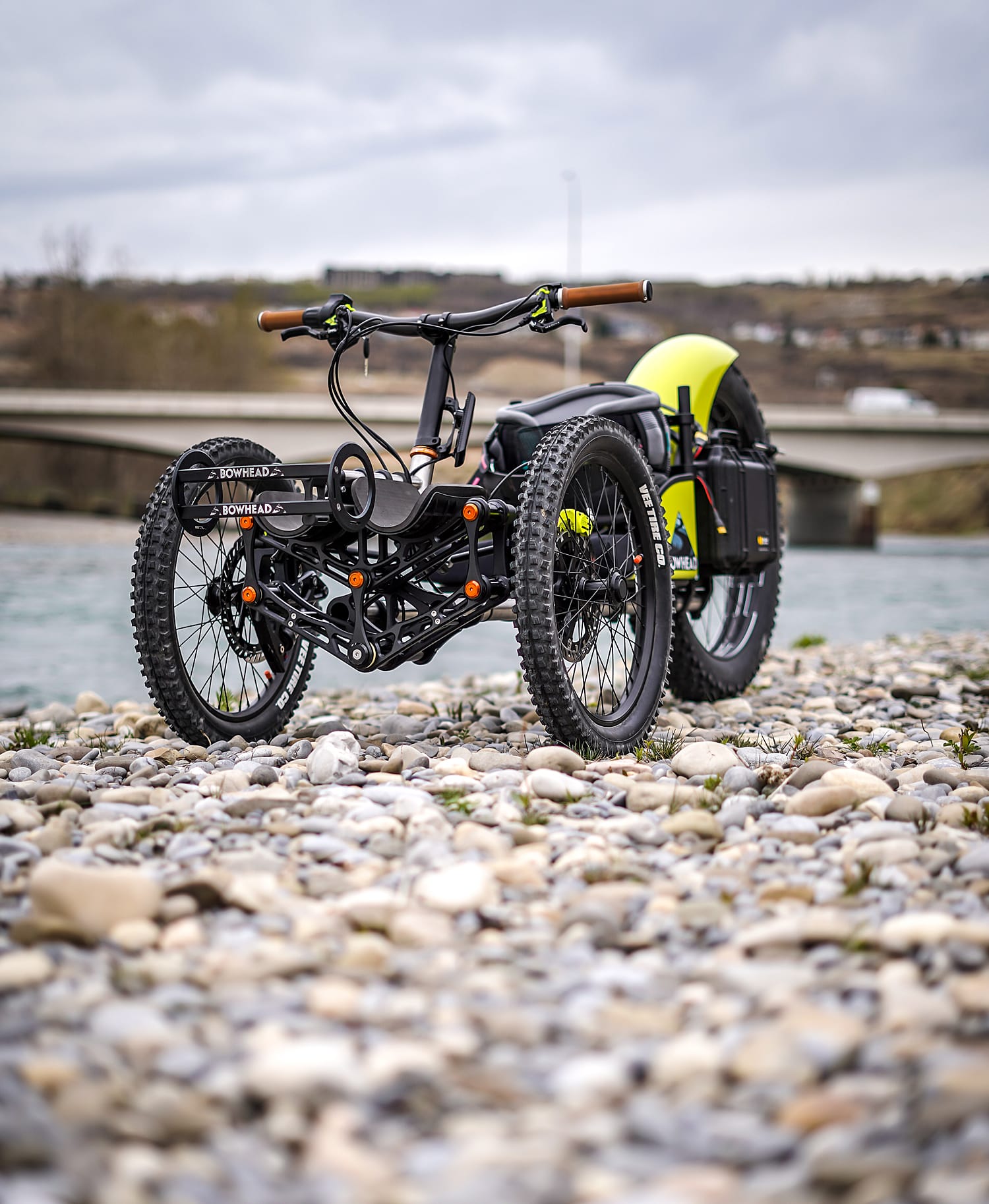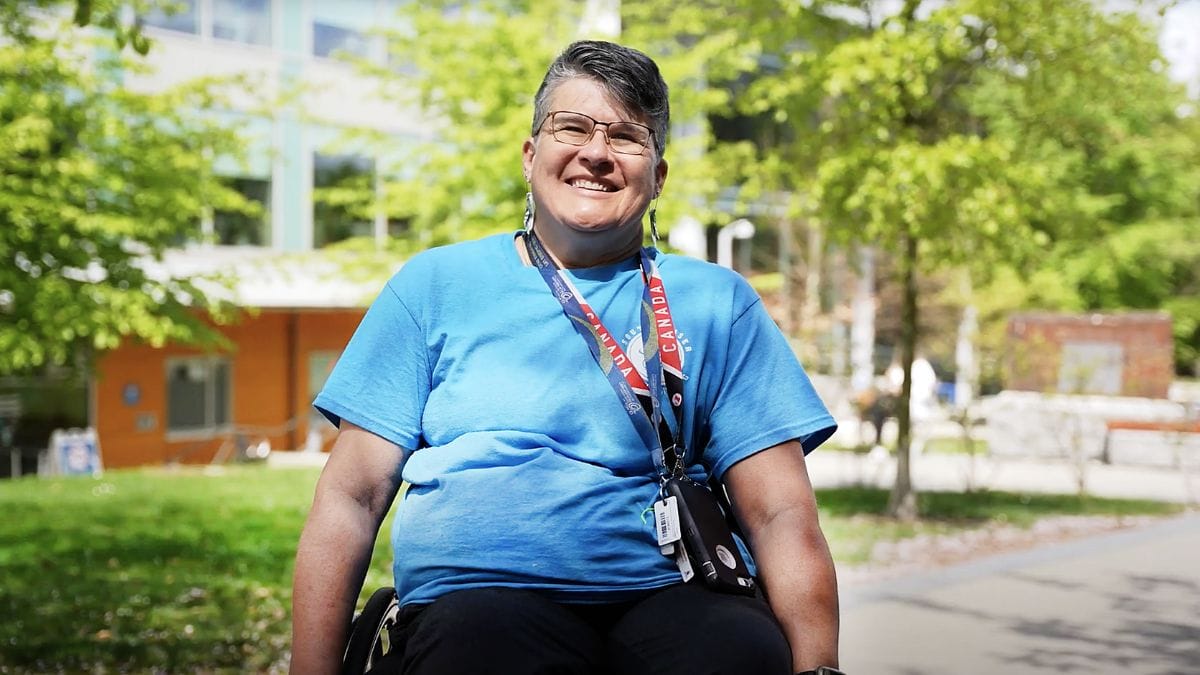
To say that Cole Bernier likes his Bowhead Reach would be like describing the Rocky Mountains as pretty good sized hills.
“The Reach for me is literally everything—it’s how I express myself, it’s an accessibility tool, it allows me to take my dog for walks, it’s a source for me to be able to go and blow off steam when I’m having a bad day or the icing on the cake when I’m having a great day,” says Bernier, a 28-year-old from Kelowna who was injured on the job (L1/T12) in 2015. “The thrill it provides me and the speed it’s capable of carrying me down a DH (downhill) run can’t be compared to any other adaptive bike that I’ve seen to date. Most of the time I’m chomping at my (able bodied) riding buddies’ rear tires, which isn’t really something you’d expect to be able to do on an adaptive bike.”
In fact, Bernier is so fast on his “Bowshred” that he won two legs of the aMTB division of the prestigious 2021 Dunbar Summer Series of downhill mountain bike racing. The three race event, which took place at three Rocky Mountain locations, marked the first time aMTB, or adaptive mountain biking, was included as a series category.
But Bernier makes it clear: Bowhead is much more than a racing bike.
“To me, that is the coolest thing about the Reach. You have athletes who are breaking ground and racing DH races where they’ve never been able to before, but then you also have your average person that just wants to get out and go for a hike with their family. Both of these applications, and everything in between, are so important, as everyone expresses themselves differently and values different things in life. So to be able to just hop on a piece of equipment and go and ride whatever it is you feel that day is pretty unreal, if you ask me. It really is the most versatile piece of adaptive equipment available to us today.”
If you’re thinking Bernier might be a great sales or spokesperson for Bowhead, the company’s founder, Christian Bagg, thought so as well—he hired Bernier last July as Customer Experience Coordinator.
“I manage tech support, parts ordering, and customer info intake for new builds,” says Bernier. “I’m also fortunate enough to help with product testing and development. Honestly, Bowhead has provided me with my dream job. I get to work alongside some of the most amazing people within our company, but also the most amazing and inspiring clientele on the planet.”

BOWHEAD: A BRIEF HISTORY
Most likely, many readers already know of Bagg and his Bowhead Reach. After all, the Calgarian and his revolutionary invention have been featured in almost every mountain biking magazine and website, countless newspapers, and many TV news segments around the world. But just in case you missed it, here’s a quick recap of the Bowhead story.
When he was injured in a snowboarding accident back in 1996, Bagg was two years into an apprenticeship as a machinist. After his injury, he was soon tinkering in his workshop, and mobility devices became his focus. He couldn’t find a manual wheelchair that truly fitted his 6’4” frame, so he built his own. That led to a collaboration with Toronto Paralympian Jeff Adams—the duo created two manual wheelchair companies, Marvel and ICON.
But what Bagg really enjoyed doing was finding ways to get into the backcountry— not easy when you’re a T7-9 paraplegic. Cross country skiing was his favourite outlet, but he discovered that the problem with sit ski frames was their instability when traversing sideways across a slope—the entire frame tilted at the same angle as the slope, and he had to lean up to avoid tipping over, putting him in an awkward position to steer or pole.
Bagg solved the problem by developing a pivoting, or articulating, frame. The design allowed one ski to drop and the other one to rise to match a side slope of up to 30 degrees, while allowing him to remain stable and vertical in his seat bucket. It was a complete success—so much so that he was inspired to apply the design to an off-road handcycle he’d also been working on in his spare time. All of a sudden, he found that he could be stable on side slopes—and lean into corners at high speeds.
Thus began Bagg’s seven-year journey to create Bowhead Corporation and its flagship model, the Bowhead Reach.
Initial prototypes were pure mountain bikes, powered solely by arm cranks. Bagg began building them for customers out of the basement of his Calgary home. When one customer requested an electric motor, Bagg balked—as a cycling purist, he thought this would compromise his invention. Eventually, he relented—and when he tried it himself, he was immediately hooked.
“It was pretty clear the moment right after putting the motor on and riding it—I realized that I’d really been missing out the whole time,” says Bagg. “This was way more fun, and answered the question, ‘How do you get back up the hill so you can go down?’ Well, you need the motor. The motor really gave me that freedom to not be reliant on anybody; to go out on my own. It was freedom, and that’s what the motor started to represent.”
He threw himself into refining the concept, and what emerged was the Bowhead Reach.

BEAUTY AND BEAST
The Reach looks nothing like any other handcycle or aMTB ever built. At the front, there are two 20-inch BMX rims with knobby tires that are steered with a regular bike handlebar. Supporting the two front wheels is Bowhead’s secret sauce—the articulating front end made up of two shock-loaded parallelogram frame sections. At the back is a massive, fat 26-inch drive wheel. In between is the scoop seat, a powerful electric bike engine, the battery compartments, and handlebars with throttle and levers for the bike’s disc brakes. Sitting still, it looks rugged and refined at the same time.
Early users of the Reach were quick to push the limits. Videos appeared of riders hurtling down single track trails (it’s only as wide as a standard set of mountain bike handlebars) and getting big air. And that’s when the buzz started.
“I didn’t even realize this was a thing,” recalls Bagg. “For me, the Eureka! of just being able to go out on a trail seemed to satisfy me. I thought that was a big enough deal. But here were these people with a fresher idea in their mind of what they wanted to do, based on the life they came from, and I think it just seemed natural to them that it would jump. They looked at it. They sat on it. It rolled down mountains. It rolled over dirt. Why wouldn’t it roll over a jump?”
As interest grew, so did Bagg’s company. Dean Miller, an engineer from Michigan who Bagg knew from his days when both worked in the mobility equipment field, came aboard and took on the role of President and CEO, allowing Bagg the freedom to focus on advancing the design as the company’s Chief Technology Officer. Recognizing that the USA would be a far larger market, a manufacturing and distribution centre was established in Michigan, while design and assembly continued in Calgary. Meanwhile, staff were hired to meet the growing demand.
During this time, two variations of the original version were developed. The Bowhead AWD Adventure-E Bike features an electric motor for each of the three wheels. While the weight of the motors and additional batteries makes this version less nimble and fast, its tremendous torque makes it great for climbing and crawling. And the Bowhead Trailblazer Adventure-E Bike features a set of rear mounted controls, allowing a hiker on foot to operate the bike for someone with an injury level of disability that prevents them from using it independently.
As for riders with higher injuries, Bagg has been committed to getting them on the Reach since the outset. He’s developed both specialized throttle and brake controls that can be safely operated using wrist flexors by those with limited dexterity and hand strength. And for those with limited trunk strength, he’s also developed an elastic tensioning system for the articulating front suspension that helps keep the user vertical before, during and after negotiating a sidehill.
“A quarter of our riders are quadriplegics,” he explains. “They committed a bunch of money to get a bike, with a commitment from us that we would try to make it work well for them. So it makes sense that we listen to them and try to make it a better experience for them.”
As sales continued to climb, Bagg realized that research and development had to continue, and he and his small team of engineers worked on a more refined version of the initial model. As this issue is being prepared, the company is in the process of rolling out its new model—the Bowhead RX Adventure-E Bike.

Unlike the original electric-only Reach, the RX is a true e-bike—it has hand cranks for cycling purists, while a powerful electric torque-sensing motor kicks in when needed or desired to augment arm-only power by three and a half times. It’s the best of both worlds—the RX can be used as a fitness machine, satisfying a requirement for many funding agencies in the US, but it remains a nimble downhill sprinter. Other features include a motocross-style single pivot swing arm back suspension, and 12-speed electronic shifting.
The hand cranks present some challenges in terms of being able to provide adaptive throttle and braking controls suitable for quadriplegics, but the company is making good progress with this.
STICKER SHOCK
When you search online for reviews about Bowhead Reach, you’ll find plenty. And what you’ll find is that most reviewers are just like Bernier—they don’t just like it, they rave about it.
The only thing that’s a stumbling block for some is the price. The base model of the Reach is about $21,000 CDN, and options like titanium and carbon fibre frame upgrades can raise that significantly. The RX, meanwhile, with it’s true e-bike features, will cost about $1,500 more. Bagg concedes the price tag is steep for many individuals aspiring to own their own Bowhead. But he defends the price by explaining that the Reach uses about 140 unique parts that have to be fabricated on a small scale by Bowhead and several partner companies. Add in welding, machining, assembly, hydraulics, wiring, battery cells and everything else, and the cost climbs quickly—particularly in a climate of supply chain woes.
However, he says it’s a priority to develop a more affordable basic model, providing he can ensure the experience, along with safety, aren’t diminished in the process.

In the interim, Bagg and Bowhead are committed to exploring a multitude of ways to get people into a Reach or RX without breaking the bank. He’s happy to help would-be buyers secure assistance from funding organizations. And he’s a big fan of facilities, organizations, and provincial and national parks buying one or more and making them available to visitors and guests (currently, you can rent a Reach from CRIS Adaptive in Kelowna or Kootenay Adaptive Sport Association in the Kootenays).
“When people do get in touch with us, and are frustrated about the price, we don’t just tell them, ‘Well, that’s the world we live in.’ We ask them, ‘Where do you live? What’s your situation? Are there funding organizations nearby? Can we help you get in touch with them?’ I feel for these people. They want what I wanted when we started this company— just to go outside to have some fun. We want everyone to have those experiences. So that’s how we’re tackling the cost issue—using other people’s money when we can, and making (a lower cost version) an engineering priority.”
If you’d like to learn more, there are countless news stories, reviews and videos to be found online, but a good place to start might be bowheadcorp.com.
This article was originally published in the Spring 2022 issue of The Spin. Read more stories from this issue, including:
- Bodybuilding
- Breathing techniques
- Nerve regrowth research
And more!




